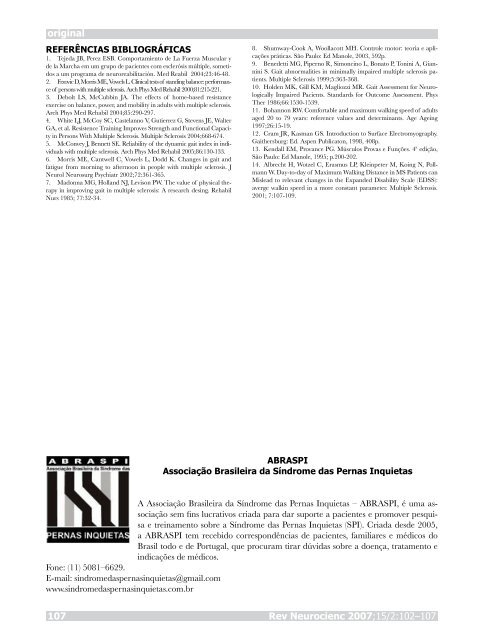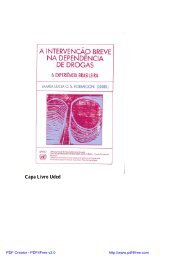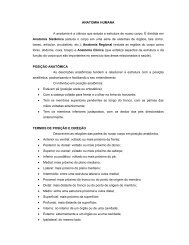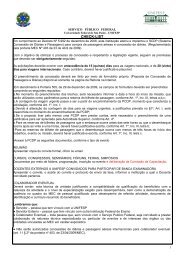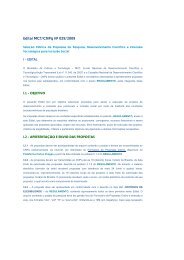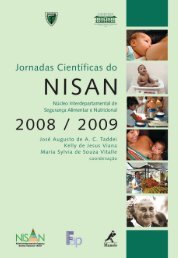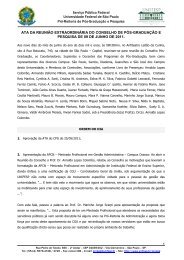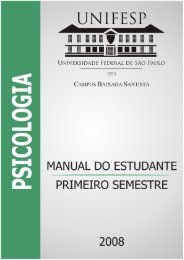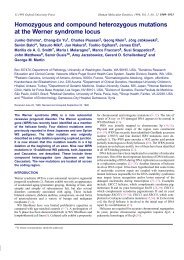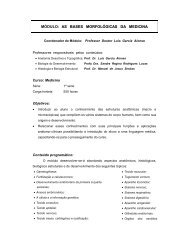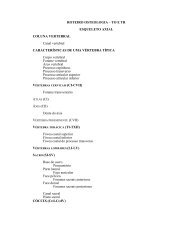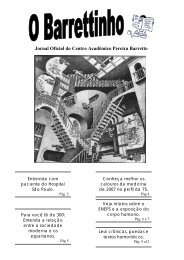Revista Volume 15 Número 2 2007 - Unifesp
Revista Volume 15 Número 2 2007 - Unifesp
Revista Volume 15 Número 2 2007 - Unifesp
Create successful ePaper yourself
Turn your PDF publications into a flip-book with our unique Google optimized e-Paper software.
original<br />
REFERÊNCIAS BIBLIOGRÁFICAS<br />
1. Tejeda JB, Perez ESB. Comportamiento de La Fuerza Muscular y<br />
de la Marcha em um grupo de pacientes com esclerósis múltiple, sometidos<br />
a um programa de neuroreabilitación. Med Reabil 2004;23:46-48.<br />
2. Frzovic D, Morris ME, Vowels L. Clinical tests of standing balance: performance<br />
of persons with multiple sclerosis. Arch Phys Med Rehabil 2000;81:2<strong>15</strong>-221.<br />
3. Debolt LS, McCubbin JA. The effects of home-based resistance<br />
exercise on balance, power, and mobility in adults with multiple sclerosis.<br />
Arch Phys Med Rehabil 2004;85:290-297.<br />
4. White LJ, McCoy SC, Castelanno V, Gutierrez G, Stevens JE, Walter<br />
GA, et al. Resistence Training Improves Strength and Functional Capacity<br />
in Persons With Multiple Sclerosis. Multiple Sclerosis 2004;668-674.<br />
5. McConvey J, Bennett SE. Reliability of the dynamic gait index in individuals<br />
with multiple sclerosis. Arch Phys Med Rehabil 2005;86:130-133.<br />
6. Morris ME, Cantwell C, Vowels L, Dodd K. Changes in gait and<br />
fatigue from morning to afternoon in people with multiple sclerosis. J<br />
Neurol Neurosurg Psychiatr 2002;72:361-365.<br />
7. Madonna MG, Holland NJ, Levison PW. The value of physical therapy<br />
in improving gait in multiple sclerosis: A research desing. Rehabil<br />
Nurs 1985; 77:32-34.<br />
8. Shumway-Cook A, Woollacott MH. Controle motor: teoria e aplicações<br />
práticas. São Paulo: Ed Manole, 2003, 592p.<br />
9. Benedetti MG, Piperno R, Simoncino L, Bonato P, Tonini A, Giannini<br />
S. Gait abnormalities in minimally impaired multiple sclerosis patients.<br />
Multiple Sclerosis 1999;5:363-368.<br />
10. Holden MK, Gill KM, Magliozzi MR. Gait Assessment for Neurologically<br />
Impaired Pacients. Standards for Outcome Assessment. Phys<br />
Ther 1986;66:<strong>15</strong>30-<strong>15</strong>39.<br />
11. Bohannon RW. Comfortable and maximum walking speed of adults<br />
aged 20 to 79 years: reference values and determinants. Age Ageing<br />
1997;26:<strong>15</strong>-19.<br />
12. Cram JR, Kasman GS. Introduction to Surface Electromyography.<br />
Gaithersburg: Ed. Aspen Publicaton, 1998, 408p.<br />
13. Kendall EM, Provance PG. Músculos Provas e Funções. 4ª edição,<br />
São Paulo: Ed Manole, 1995; p.200-202.<br />
14. Albrecht H, Wotzel C, Erasmus LP, Kleinpeter M, Koing N, Pollmann<br />
W. Day-to-day of Maximum Walking Distance in MS Patients can<br />
Mislead to relevant changes in the Expanded Disability Scale (EDSS):<br />
averge walkin speed in a more constant parameter. Multiple Sclerosis.<br />
2001; 7:107-109.<br />
ABRASPI<br />
Associação Brasileira da Síndrome das Pernas Inquietas<br />
A Associação Brasileira da Síndrome das Pernas Inquietas – ABRASPI, é uma associação<br />
sem fins lucrativos criada para dar suporte a pacientes e promover pesquisa<br />
e treinamento sobre a Síndrome das Pernas Inquietas (SPI). Criada desde 2005,<br />
a ABRASPI tem recebido correspondências de pacientes, familiares e médicos do<br />
Brasil todo e de Portugal, que procuram tirar dúvidas sobre a doença, tratamento e<br />
indicações de médicos.<br />
Fone: (11) 5081–6629.<br />
E-mail: sindromedaspernasinquietas@gmail.com<br />
www.sindromedaspernasinquietas.com.br<br />
107<br />
Rev Neurocienc <strong>2007</strong>;<strong>15</strong>/2:102–107


